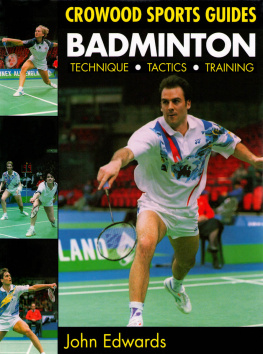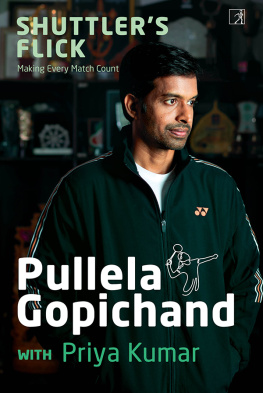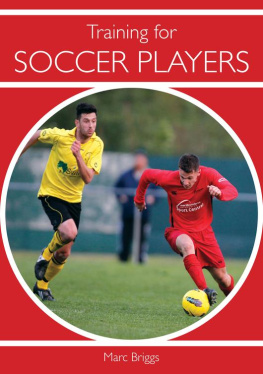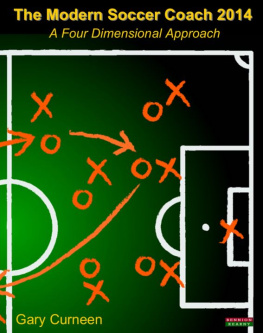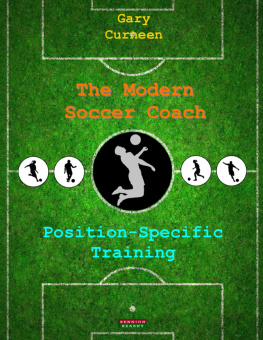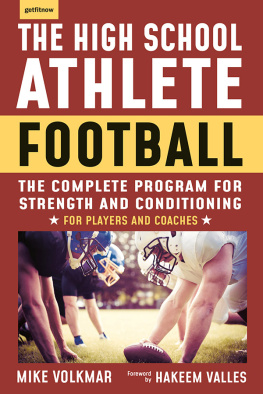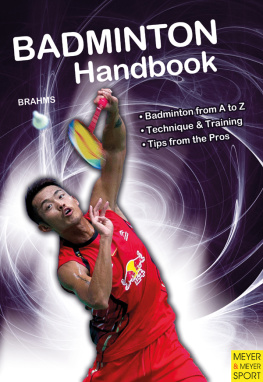High Performance
BADMINTON
Mark Golds

THE CROWOOD PRESS
First published in 2016 by
The Crowood Press Ltd
Ramsbury, Marlborough
Wiltshire SN8 2HR
www.crowood.com
This e-book first published in 2016
Mark Golds 2016
All rights reserved. No part of this publication may be reproduced or transmitted in any form or by any means, electronic or mechanical, including photocopy, recording, or any information storage and retrieval system, without permission in writing from the publishers.
British Library Cataloguing-in-Publication Data
A catalogue record for this book is available from the British Library.
ISBN 978 1 84797 930 8
Acknowledgements
Many thanks to Martin Andrew, without whose help this book would never have been completed. He has made a great impact on my life as a friend and has made a great input into this book. My thanks go to the following people for many reasons from support over the years to putting up with me on court: Rachel Marsh, coach; Nick Golds, brother and coach; Paul Golds, brother and TrionZ; Liz Austin; Andy Griffiths, fitness consultant; James Paybody, photography; Debbie Rowarth, physiotherapist; the English National U17 Squad, 2014; and Ann Golds, who introduced me to the wonderful world of badminton. I would also like to take this opportunity to acknowledge an English National Coach, who was my inspiration to become a coach myself; he had the ability to inspire players and a knack of making things easy to learn as a coach and as a player thank you, Mr Les Wright.
CONTENTS
ABOUT THE AUTHOR
Mark Golds
Marks second book (his first was published in 2002), focuses on performance badminton and is suitable for players of all ages who are interested in developing their skills and winning more matches.
Mark was born in 1965 and grew up in a sporting family who were heavily involved in badminton in Cheshire. He has an older and younger brother, who both played for the county. Mark represented England as an U18 and accumulated almost 200 caps for Cheshire at senior level, winning numerous county restricted titles in all three disciplines.
Over the past thirty years, Mark has gained extensive coaching experience and is currently a full-time coach working with players of all levels from beginners through to international-level juniors who have gained medal success in Europe. He is highly enthusiastic, with an energy that motivates and inspires the players he coaches.
Mark has continued to develop as a player and has started recently to compete with considerable success on the International Masters Circuit, winning national, European and world titles in both doubles and mixed. In 2013, he became the world champion in over-45 mixed doubles.
INTRODUCTION
Badminton is a sport like no other and it is one of the most popular in the world. In some Asian countries, it is in the top ten sports, while in Europe it is well-established and played in schools and at sports clubs. Badminton challenges sports such as golf, cycling and basketball in participation figures. Historically, the top performers had come from Europe, especially Denmark, England and Sweden, but in more recent times since the mid 1980s the Asian nations have closed the gap and overtaken the European players. The leading nations currently include China, South Korea, Indonesia, Japan and Denmark.
At the highest level, badminton is a fusion of power, speed, strength, agility, precision, athleticism, mentality and many more superlatives than we would care to mention in a short introduction about the fastest racket sport in the world.
When played at other performance levels, the nature of the sport is no less challenging and delivers competitive environments for all ages, from young juniors to senior masters.
While all sports at the top level require high levels of personal endeavour, the worlds top badminton players are without doubt among the fastest athletes in the world. They have the ability to cover short distances, from the middle of the court to intercept a shuttle, at incredible speeds for the duration of a match, which can often last for more than an hour.
The movements involved in badminton are so dynamic that it requires very organized footwork forwards, backwards, sideways and diagonally with control and speed, linking it to a high level of agility. Players need to jump multi-directionally and recover, as well as reaching low to retrieve shuttles hit downwards rapidly by opponents. Players need to be very powerful while maintaining a light body weight to make fast, explosive agile movements, stopping and changing direction for each shot played, and then recovering to be ready for the next shot.
As previously mentioned, badminton is a global sport. In many Asian countries, it is their number one sport with top players being well known and recognized when they walk down the street.
Sport Governance
The sport is governed internationally by the Badminton World Federation (BWF), an organization based in Kuala Lumpur, Malaysia.
The BWF is empowered by the International Olympic Committee and the BWFs 180 members to govern the sport of badminton worldwide.
www.bwfbadminton.org
The BWF has five continental bodies, each of which is the governing body for the sport in that continent.
The Badminton Europe Confederation is based in Denmark. Its role is to lead on the regulation, promotion, management and development of badminton on the Continent. It was founded in 1967 and now has fifty-two member associations.
The Sport
Badminton is an Olympic sport, making its competitive debut in 1992. In many respects this involvement alone altered the structure of the sport and raised the standard of so many countries. At a development level, many countries are starting to play the game and increase its popularity and awareness. The BWF membership has risen noticably since badminton entered the Olympic arena, up to the 180 member associations we see today. At the performance end of the spectrum there are far more countries competing in the top level tournaments and successful players are now coming from many more nations. For example, when Carolina Marin from Spain won the womens singles in the World Championships in 2014, this title had only been won by a European woman once since 1978 (Camilla Martin of Denmark in 1999). Prior to this win by Marin, Spain had not been considered a country that could produce players to challenge at the top of the sport.
Badminton has become a highly popular spectator sport and catches peoples imagination whenever they watch it for the first time. On more than one occasion since it first appeared in the 1992 Olympics, badminton has seen viewing figures rival the blue ribbon event in athletics, the mens 100 metres final. This is mainly down to the popularity of the sport in Asia, but also pays tribute to the advancements the sport has seen in other parts of the world.
The Fastest Racket Sport
Badminton is the fastest racket sport. Advancements in television broadcasting and technology now bring us some amazing facts and statistics about sports. The speed at which a shuttle can travel off a players racket head is far higher than that seen in the other racket sports, although many non-badminton people struggle to believe this fact.
The high level of physicality of players has enabled scientists to increase their knowledge about the biomechanical functioning of the body and link this to the advancements in technology in rackets and strings. It is a combination of all the factors above that has made badminton such a high-octane sport compared with others.
Tennis and squash are probably the sports closest in similarity to badminton, but a difference is noticable in the speed at which a shuttle can be hit compared with a tennis ball or squash ball.
Next page

